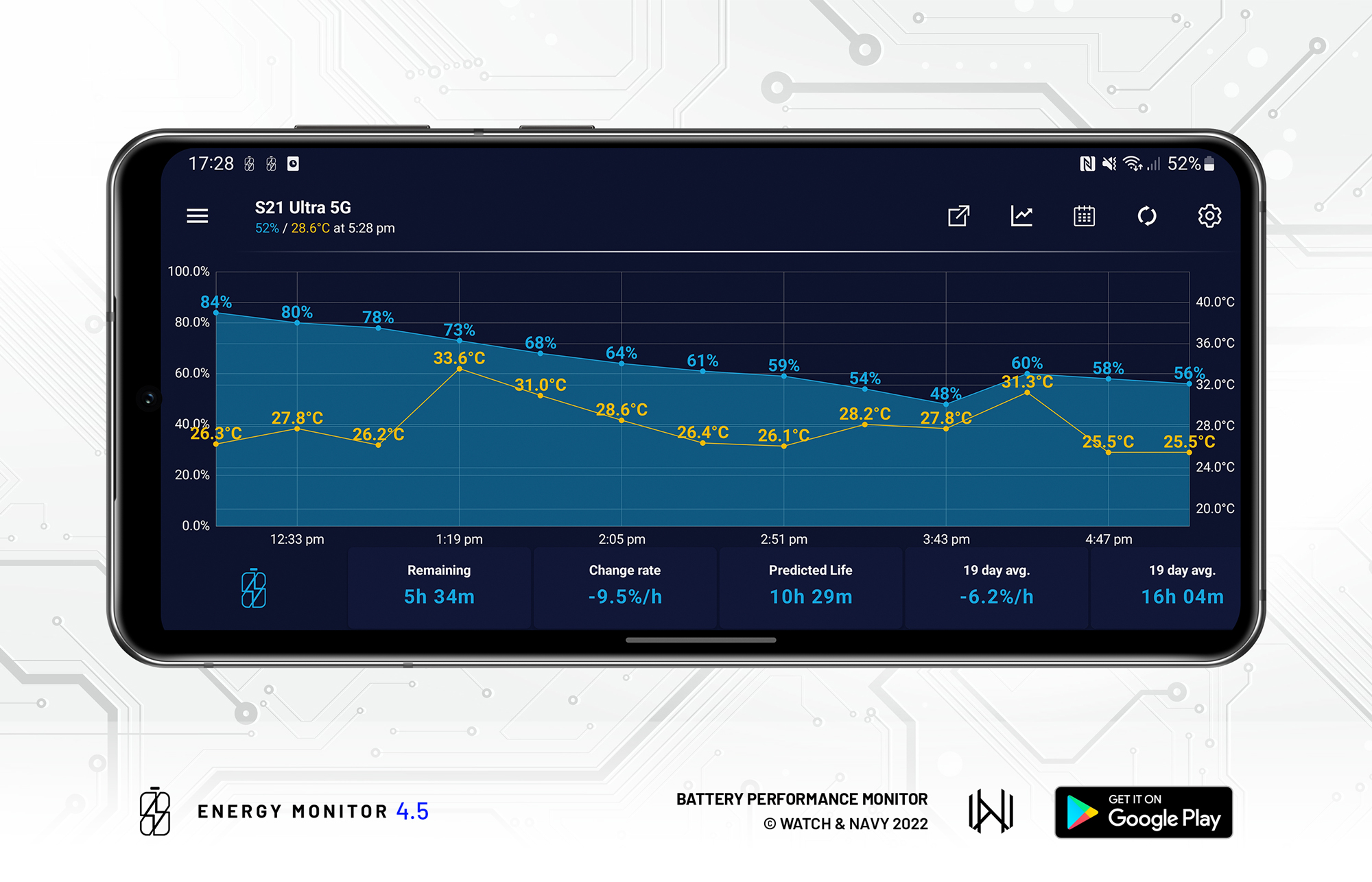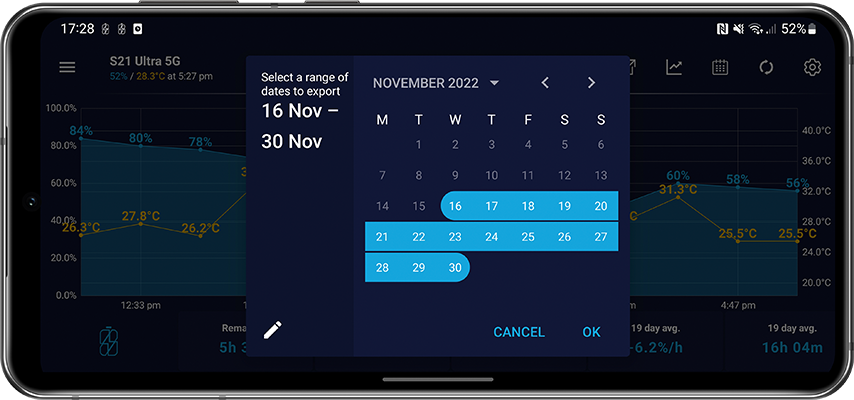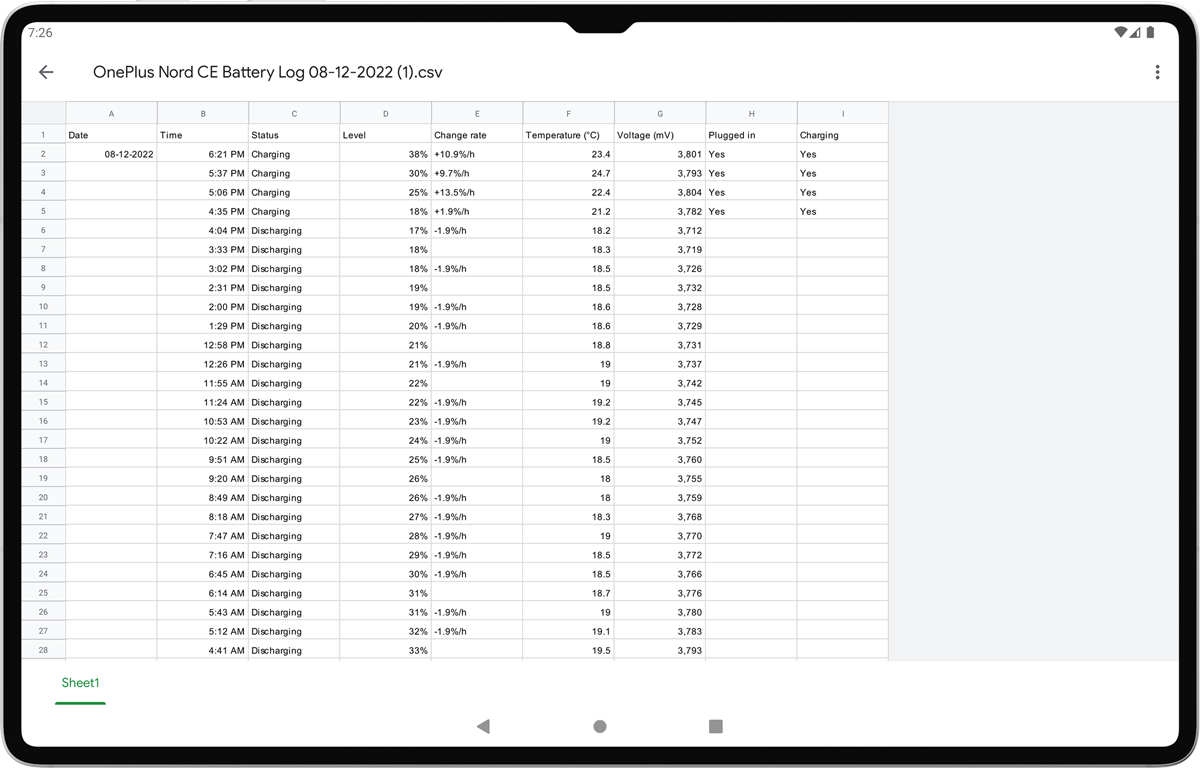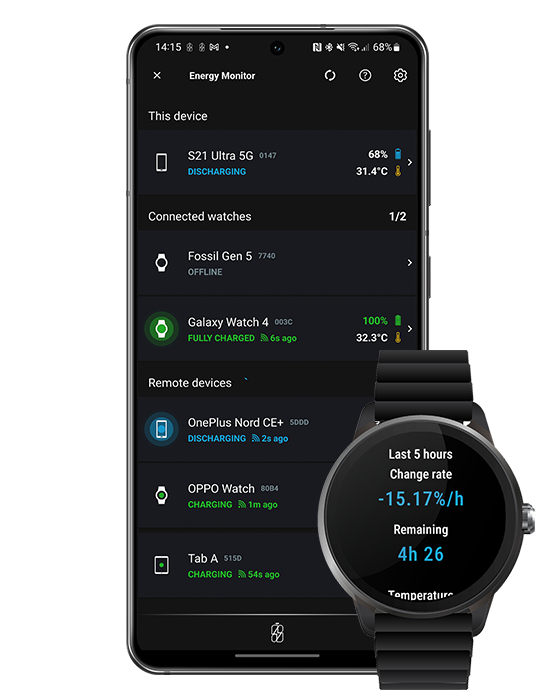The Energy Monitor 4.5 file export capability enables you to create detailed battery performance reports for in-depth technical analysis. This guide explains how you can record and export battery performance data from your Android and Wear OS devices, and describes the three different file formats currently available.

Energy Monitor is a performance and temperature monitor for Android phones, tablets and Wear OS smart watches; especially designed to be highly efficient in its own energy footprint. You can predict your battery life for the day, monitor devices remotely, and always know in good time when any of your batteries are draining faster than usual.
How to export data


Tap on any device in the device list to open the log viewer, and then tap on the export icon (pictured left) to start the process of creating your file. The app will guide you through the following steps:
- Choose one of the file formats listed below
- Select a range of dates you’d like to export
- Choose a folder in which to store the file
After creating your file, the app will prompt you to share the output file in any messaging or storage app of your choosing.
File contents
At the top of your exported file you will find some basic information on your device:
- Model and manufacturer
- Battery type (i.e. Li-ion)
- Battery capacity (in milliamp hours)
…Followed by the ‘log summary’ of calculations made from the entire exported dataset:
- Average discharge rate (if available)
- Average charge rate (if available)
- Longest, shortest, and average recording interval
- Highest, lowest, and average temperature
- Highest, lowest, and average voltage
…And lastly the performance log. Each log entry consists of the following:
- Battery level
- Temperature
- Voltage
- Change rate (in % per hour, calculated from the previous entry)
- Plugged-in status
- Charging status
💡 You can choose to have your battery logs sorted by newest-first or oldest-first by changing the ‘export sorting order’ under the ‘file exports’ section in the general settings menu.
File types
1. Comma-separated values (.csv)
The CSV format arranges organises your data into a table, making it easy to perform your own calculations on the data. CSV files are readable by any well-known spreadsheet app such as Microsoft Excel, Apple Numbers or Google Sheets.
Your preferred temperature and electric potential (voltage) units are named in the header of each column.
Example

💡 The CSV format does not include a log summary.
2. Plaintext document (.txt)
Plaintext is an easily portable format that does not require any specialised program to be read. This format can easily be styled and converted into a PDF or Word document.
Example
S21 Ultra 5G Battery Performance Log
12:17 am 01/12/2022 - 7:41 pm 06/12/2022
Hardware: samsung SM-G998B
Battery type: Li-ion
Battery capacity: 4,855 mAh
Exported at: 7:50 pm 06/12/2022
Average drain rate: -6.3%/h
Longest interval: 0h 00m
Average interval: 0h 23m
Longest interval: 3h 23m
Lowest temperature: 18.7°C
Average temperature: 27.0°C
Highest temperature: 43.0°C
Lowest voltage: 3,486 mV
Average voltage: 3,959 mV
Highest voltage: 4,343 mV
Created by: W&N Energy Monitor
App version: IM-4.5.2
------------------------------
06-12-2022
------------------------------
7:41 pm
Status: Discharging
Level: 63%
Change rate: -7.8%/h
Temperature: 29.6°C
Voltage: 3,921 mV
------------------------------
7:18 pm
Status: Discharging
Level: 66%
Change rate: -7.8%/h
Temperature: 25.5°C
Voltage: 3,957 mV
------------------------------
6:55 pm
Status: Discharging
Level: 69%
Change rate: -2.6%/h
Temperature: 24.6°C
Voltage: 3,985 mV3. JavaScript Object Notation (.json)
JSON is the most commonly used data format for transferring data between modern mobile and web applications. It is designed to be practical for processing by machines, rather than for human readability.
Temperature and electric potential (voltage) values are stored in each log entry numerically. The ‘units’ object in the root of the document will tell you the corresponding unit for these values, such as ‘celsius’ and ‘millivolts’.
Example
{
"device":{
"name":"S21 Ultra 5G",
"model":"SM-G998B",
"manufacturer":"samsung",
"battery":{
"technology":"Li-ion",
"capacity":"4,855 mAh"
}
},
"units":{
"temperature_unit":"celsius",
"electric_potential_unit":"millivolts"
},
"log_summary":{
"start_date":"12:08 am 06/12/2022",
"end_date":"7:41 pm 06/12/2022",
"length":52,
"shortest_interval":"0h 00m",
"average_interval":"0h 22m",
"longest_interval":"0h 23m",
"average_drain_rate":"-7.8%/h",
"highest_temperature":41.9,
"average_temperature":26.826923,
"lowest_temperature":19.7,
"highest_voltage":4342.0,
"average_voltage":4088.3655,
"lowest_voltage":3715.0
},
"creator":{
"created_by":"W&N Energy Monitor",
"app_version":"IM-4.5.0 CC"
},
"log":{
"06-12-2022":[
{
"time":"7:41 pm",
"status":"Discharging",
"level_percent":63,
"change_rate":"-7.8%/h",
"temperature":29.6,
"voltage":3921.0,
"plugged_in":"No",
"charging":"No"
},
{
"time":"7:18 pm",
"status":"Discharging",
"level_percent":66,
"change_rate":"-7.8%/h",
"temperature":25.5,
"voltage":3957.0,
"plugged_in":"No",
"charging":"No"
},
{
"time":"6:55 pm",
"status":"Discharging",
"level_percent":69,
"change_rate":"-2.6%/h",
"temperature":24.6,
"voltage":3985.0,
"plugged_in":"No",
"charging":"No"
}
]
}
}💬 Have an idea for a new format? We welcome your suggestions.
How to record battery performance logs

Simply install Energy Monitor 4.5+ on your Android phone or tablet, your Wear OS smartwatch, or even Chromebook laptop. The app comes ready to record your battery performance periodically throughout the day, and will issue useful heads-up warnings and predictions when it detects changes in your battery performance. While the factory settings will serve most use cases, you will also find a wide range of settings for you to customise to your personal preferences.
The file exports capability was one of the most requested features throughout the year of 2022. We hope you find that it meets the needs of your personal and professional use cases. Keep the feedback coming on what we can improve; we will gladly to support and prioritise the most requested features.
Download Energy Monitor 4.5 on Google Play:

Follow us on Instagram, Facebook and LinkedIn.